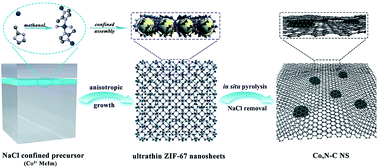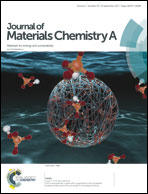In situ synthesis of ultrathin metal–organic framework nanosheets: a new method for 2D metal-based nanoporous carbon electrocatalysts†
Abstract
Two-dimensional (2D) metal–organic framework (MOF) nanosheets, which possess the advantages of both 2D layered nanomaterials and MOFs, are considered as promising nanomaterials. However, it is still difficult to directly synthesize MOF nanosheets. Here we for the first time report a new bottom-up strategy for in situ synthesis of high-quality ZIF-67 nanosheets with the salt-template assistance. The as-prepared ZIF-67 nanosheets exhibit a uniform morphology and ultrathin structure with a thickness of 4.5 nm. Furthermore, because of the highly open structure, larger surface area, more accessible active sites and smaller diffusion barrier compared with bulk-sized MOFs, the directly carbonized Co,N-doped nanoporous carbon nanosheets also greatly boost the oxygen reduction reaction (ORR). More importantly, the general synthesis process indicates that this effective salt-template confined bottom-up strategy can be expanded to synthesize other ultrathin 2D MOF nanosheets with extensive applications in gas separation, catalysis, sensors, and energy storage and conversion.



 Please wait while we load your content...
Please wait while we load your content...